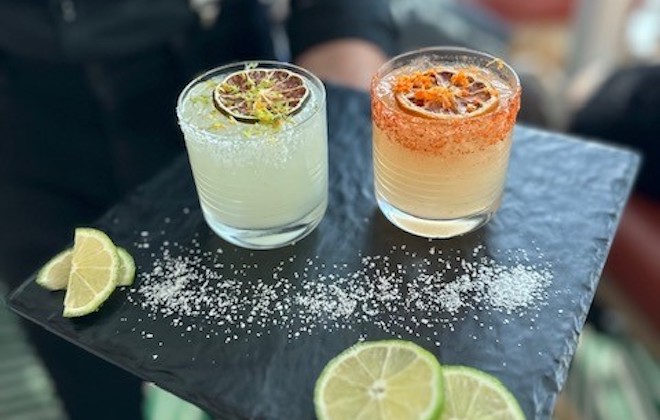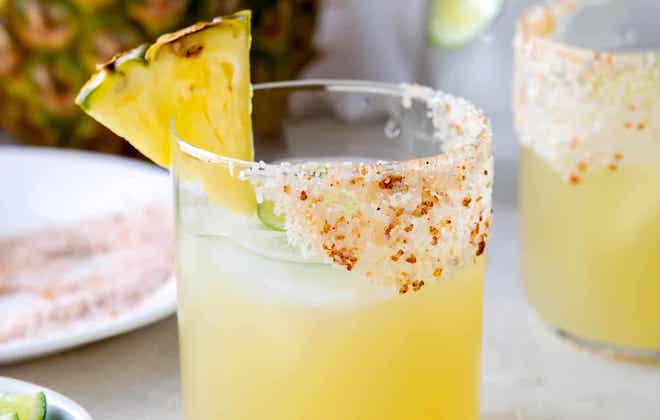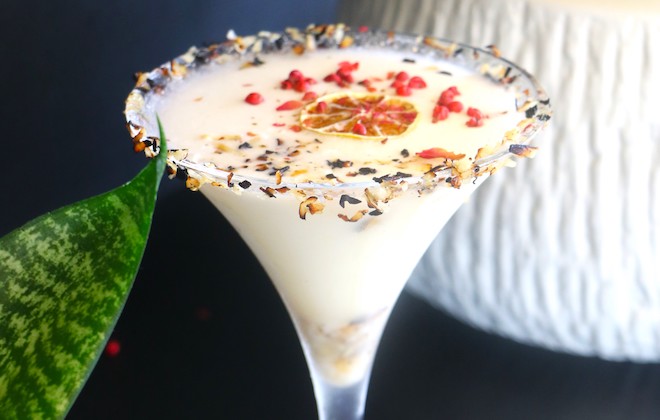There are few drinks as beloved as the Margarita. It comes in all shapes and sizes, from petite cocktails from a fancy bar to giant goblet-sized ones at (often tacky) restaurants. But it’s also an easy cocktail to make your own at home. All you need is to take the advice of bartenders for the best at-home Margarita variations.
Pay Attention To the Classic Ingredients
The Margarita is a simple cocktail. It’s close to a standard sour cocktail made with liquor, a sweetener, and lime or lemon juice. A classic Margarita just has the addition of orange liqueur like Triple Sec, Cointreau, or Grand Marnier. The first of these is the most affordable and the most common, but using a pricier orange liqueur will lead to a more balanced taste than the uber-sweet Triple Sec. Bauchant orange liqueur is a smaller brand that adds a well-rounded taste that’s preferred by Norbert Zareba, lead bartender at The Workshop Lounge at The Foundry Hotel in Asheville, North Carolina. Pierre Ferrand Dry Curacao has cinnamon spice notes and is just as great in a Margarita as it is as a digestif on ice after dinner.
The type of tequila you choose is important as well. Blanco tequilas will lead to the most straightforward and clean agave flavors. You don’t necessarily need to pour your favorite sipping tequila, though better tequila will lead to better Margaritas (up to a point, at least). A deeply herbaceous tequila like the blanco from Tequila Ocho or a peppery tequila like El Tesoro’s blanco will reflect those same flavors in your cocktail. That said, easy drinking options from the likes of Patrón or Casamigos will do the trick when you’re looking for something straightforward. At the end of the day, what you’re really looking for is the natural agave notes in tequila to balance the drink.

Credit: Hotel AKA Brickell
“Any tequila blanco will do,” says John Grey Gomez, lead bartender at Zala Gastro Bar at Curaçao Marriott Beach Resort. “It will give you a pure taste of the agave flavor.”
If you want the spirit in your drink to stand out even more, branch out from blanco tequila. A smoky mezcal or sotol adds a nice touch, while an añejo tequila adds some depth from the barrel aging.
“The flavor of a reposado gives the margarita a strong and well-balanced flavor, and Don Julio is a personal favorite of mine,” says Brett Bukofser, senior food and beverage manager at InterContinental New York Barclay.
Last but not least there’s the citrus. Fresh-squeezed lime juice leads to the best classic Margarita. From there, you can modify your cocktail by swapping in other citrus like grapefruit, blood orange, or tangerine, Gomez notes. You can even use another sour fruit, like passion fruit.

Credit: Thompson Playa del Carmen
One ingredient that’s often ignored? Water, which comes from the ice that melts as the cocktail is made.
“Dilution is very important to balance the flavor,” says Subhash Sankar, head mixologist at Alaia Belize, located on Belize’s largest island. “Shake until the outside of the shaker frosts up.”
You don’t have to get your dilution down to an exact science, but there is an ideal rate you’re looking for.
“You want your dilution rate to be between 15 percent and 25 percent of your entire cocktail build,” says Carlos Lassalle, bartender at Hotel AKA Brickell. “Shake for a slow count of ten or until the outside of the shaker frosts up.”
It’s more than just dilution that’s happening with a good shake, too.
“When a drink is shaken, it ventilates, which is essential to perfectly mix the alcohol with the water and helps to refresh and flavor the ingredients or citrus elements and thus be able to achieve a harmonious, balanced, indivisible and pleasant Margarita,” says Ezequiel Barbosa, bars supervisor at Thompson Playa del Carmen.
Start With a Simple Ratio
Start with the basic ratio: two ounces of tequila, one ounce of lime juice, and .5 ounces of orange liqueur. This is the ratio that you’ll want to come back to time and time again. But it’s not the only ratio. Different bartenders prefer different proportions, like two parts tequila to one part lime juice and one part orange liqueur or other sweetener. Once you’ve mastered the classic, try out a few variations to see what ratio you like best.
Modify Your Ingredients To Fit Your Tastes
It’s simple to change a base Margarita to match the flavors that you’re looking for.
“Easy modifications are swapping out the orange liqueur for other flavored liquors,” says Dakota Marchio, director of food and beverage at the Hotel ZaZa locations in Texas. “Giffard makes a huge line up of flavored liqueurs, and the peche (peach) and fraise de bois (strawberry) both pair well in a Margarita.”
Sankar notes that organic blue agave syrup leads to a rich-flavored Margarita, while fruit is a common addition to change the profile entirely. Sankar’s favorite is Thai coconut, while Gomez appreciates a fresh herb like mint and a little bit of orange juice on top. The options truly seem limitless when using the classic recipe as a base.

Credit: Aliaia Belize
“Infuse the tequila with jalapeno for a spicy margarita in a mason jar for 24 to 48 hours and add some watermelon puree for a fun summer cocktail,” Bukofser says. “Add a personal touch with a Tajin rim for a fun spicy margarita.”
Spice is an always popular modification for Margaritas. Simply muddle in some fresh jalapeño or add spicy bitters to the drink for an easy punch-up. Or you can infuse simple syrup with spicy peppers to use as a sweetener that also has a kick.
If you’re really into the experimenting mood, Marchio notes that Group Therapy at Hotel ZaZa Austin acid adjusts fruit by adding citric and malic acid powder. This brings up the tartness of any fruit that you want to center your Margarita on as a replacement for lime.
However you adjust your Margarita, just know that it’ll take some practice to get it just right. But it’s a fun type of practice.




